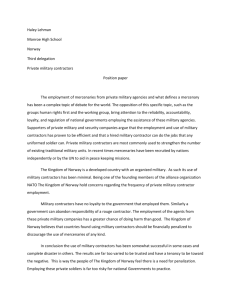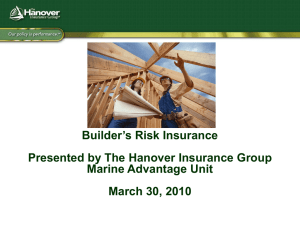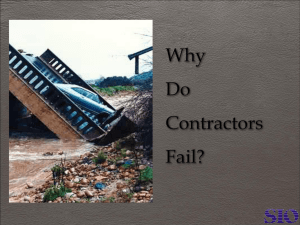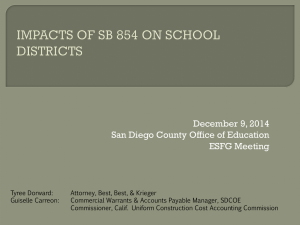Contractor Management 2 - In this post-modern era
advertisement
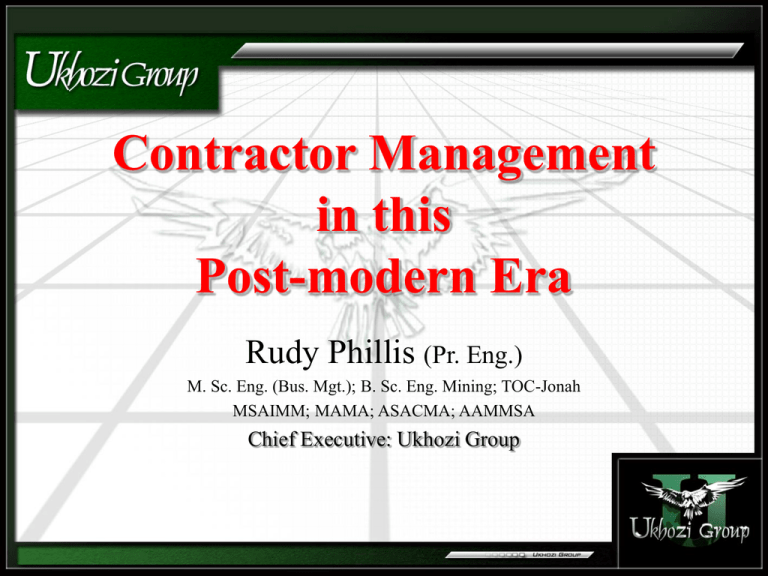
Contractor Management in this Post-modern Era Rudy Phillis (Pr. Eng.) M. Sc. Eng. (Bus. Mgt.); B. Sc. Eng. Mining; TOC-Jonah MSAIMM; MAMA; ASACMA; AAMMSA Chief Executive: Ukhozi Group Introduction • Mining Industry Concern: “Contractor Management and their safe operation, in our industry” Workshop Objective: • – • BEST PRACTICE TOOLS FOR CONTRACTOR MANAGEMENT What to change? & To what to change to? – – Technical Questions The 5th Discipline (Peter Senge): 1. 2. 3. 4. 5. • Personal Mastery, Mental Models, Build Shared Vision, Team learning, & Systems Thinking Focus: “HOW TO CAUSE THE CHANGE?” – Falls within fields of Psychology & Psychiatry COMPROMISE Safe Productivity How to cause the change ? Emotional resistance Perceived threat on security / satisfaction Every improvement is a change Every change is not an improvement Perception drives emotion Most Management / Labour prefer comfort zones CULTIVATE Safe Productivity Emotional resistance Perceived threat on security / satisfaction Every improvement is a change Every change is not an improvement How to cause the change ? Emotion of the inventor is stronger than resistance Perception drives emotion Most Management / Labour prefer comfort zones Induce Improvement BEE Partnerships Core Conflict Business Fundamentals Pressure to promote & protect Convention Socio- Political Imperative Pressure to promote & protect BEE SUSTAINABLE DEVELOPMENT BEE Partnerships Core Conflict Conventional ‘modes of operations’ works Business Fundamentals Pressure to promote & protect Convention Socio- Political Imperative Pressure to promote & protect BEE SUSTAINABLE DEVELOPMENT BBSEE Charter is Law Background • • Objective: Common frame of reference Management in Antiquity – • Evolution of Management Theory – • (Source: Russell, R. S., & Taylor III, B. W. – Production & Operations Management) Quest for a Postmodernist Theory – • • (Source: Griffin, R.W. – Management 3rd Edition) (Source: Blignaut, J. N., Department of Economics – Pretoria University) Characteristics of the paradigms Cosmological views of the paradigms Management in Antiquity • Practice of management dates thousands of years – • • • 3000 B.C. – Summarians, Greeks, Babylonians Management not considered a serious field Economics - the first discipline devoted to commerce Economists believed managerial practice to be efficient – • • Focus was on Economic Policies & Non-managerial aspects of business Business (Family) goals were survival not growth Organisations were governmental – – Unlimited powers over taxation Little accountability for waste Evolution of Management Theory • 1700s – Industrial Revolution: Widespread production of consumer goods 1776 – Adam Smith ‘Wealth of nations’ – labour division – Unprecedented advance in technology 1800s – Advent of Cost Accounting & other controls 1900s – Scientific Management – Taylor 1700s-1960s – USA dominance 1970s – International competitiveness led by Japan • • • • • – • Conversion from mass production – lean manufacturing 2000s – Y2K (No real return on IT investments) Quest for a Postmodernist Theory Ancient Imperialism 1 2 Feudalism Socrates Plato Aristotle 3 Mercantilism 4 Black Death 5 500sBC • PostModernism Paradigm Modernism Paradigm 476s 1350s 1500s Source: “Economic Industrial Revolution 1770s Sustainable Development 1970s Thought: A passage through time & a Quest for a postmodernist theory” by: Prof. Blignaut (Pretoria University) Characteristics of Paradigms • Modernism – Human being as a rational, autonomous being – Universe (nature) as object of the needs of the human being – Absolute, deterministic influence of science & technology – General optimism with regard to the prospects of development and growth – i.e.: Improvement – Truth as objective and neutral • Post-modernism – Human being as a relational being – Universe as dynamic organism – Science: chaos & qualitative – Development and progress – scarcity & limitations – Truth, objectivity & neutrality subject to the role of belief & value systems “Not merely an adaptation of old Paradigms” Cosmological View • Modernism – – – – • Post-modernism Stable Closed Determined Predictable / measurable / controllable Problem: How is it done? – Unstable / chaos – Open (holistic) Systems thinking – Relative / randomness / indeterminacy – Complex Holistic / Systems Thinking / Scientific Approach • • Metaphysics, Ethics, Logic & Epistemology Three distinct stages of Science: 1. Classification 2. Correlation 3. Cause & Effect • Only when stage 3 is reached is the subject a science Cause & Effect • Effect-cause-effect – Research starts with one effect 1 Effect 2 3 Predicted Effect (different in nature) Hypothesize a Plausible Cause • Once Predicted Effect is found does the research gain the name of THEORY Why did the apple fall down? 3 1 3 Earth revolving around the Sun Falling Apple Electron revolving around a neutron 2 Gravity LAW governing Management 4 1 3 Logistics / Distribution Management Production Management Project / Engineering Management 2 LAW • Operations Management = 1+4+3 Business Complexity • Holistic 1 4 Finance Management Operations Management 3 People Management 2 LAW 5 Strategic & Tactical Management 7 Market Management 6 Sales Management BEE Partnerships Core Conflict Conventional ‘modes of operations’ works Business Fundamentals Pressure to promote & protect Convention Socio- Political Imperative Pressure to promote & protect BEE SUSTAINABLE DEVELOPMENT BBSEE Charter is Law Contractor issues • Contractor professionalism is somewhat wanting – Site management take chances – behaviour management – Resource management cost not discounted when estimating • Entrepreneurship mentality (“one wo/man show”) – • Disability of developing human resource capacity Contractor disability to grow NAV (Net Asset Value) – • Plant/Machine acquisition vs Premium for Plant Hire Partnership mastery procedure is wanting – • Disputes resolution – “Customer is King” (Judge & Jury) Contract feasibility – Banks want more – Cost of Capital – interest rates higher than Clients – Contract profit / period Belief / understanding of Complex Sytems I LHS RHS G D A H E B C A E I H (i) What to change ? Contractors compromise Safe Productivity Contractors feel pressure to take chances i.e.: skip steps / short cuts Contractors work with unreliable resources for the remaining contract life Contracts are at the End-of-Life Resources are at the End-of-Life Contractors are forced to make plans to finish works without “King” assistance Contractors are under pressure to finish works, already delayed due to unreliable resources Financial Institutions insist on long-term contracts & credibility Contractors cultivate Safe Productivity Contractors applies management tools effectively & efficiently Contractors work with reliable resources for the contract life Timely issue of 5year contracts with credibility statement Resources are at Start of life cycle (i) To what to change to ? Contractor employees make use of “King” assistance of maintenance & expertise Contractor employees have all necessary resources reliably to conduct works Financial Institutions insist on long-term contracts & credibility (ii) What to change ? Contractors compromise Safe Productivity Often Contractor employees perform works that don’t fall within scope of contract Contractors are not setup to adequately manage risks/hazards of out-of-scope works Contractors simply cannot risk relations with “King” Often “King”/ employees make requests that don’t fall within contract scope Contractors are desperate for work Contractors are at the mercy of the proverbial “King” for Future Contracts (ii) To what to change to ? Contractors cultivate Safe Productivity Often Contractor employees perform works that don’t fall within scope of contract Contractors simply cannot risk relations with “King” Contractors have 5-year Contracts Contractors & Client manage risks/hazards of out-of-scope works Contracts allow for out-of-scope work Often “King”/ employees make requests that don’t fall within contract scope Contractors are subject to a fair monthly performance review system (with invoices) for Future Contracts How to cause change? I G D A H E B C A E I H Contractors cultivate Safe Productivity Emotional resistance Perceived threat on security / satisfaction Every improvement is a change Every change is not an improvement How to cause the change ? Emotion of the inventor is stronger than resistance Perception drives emotion Management / Labour prefer their comfort zone Induce invention • Socratic Method Induce Improvement – Equip management with simple, practicle tools for clear verbalization of intuition – Tools must allow for Management to test own beliefs in a critical manner & unleash true intuition – Management must facilitate a discovery process: • Employees are allowed to derive solutions to their problems vis-a-vis Management providing solutions – Help employees recognize the limits of their knowledge & motivates them to learn Conclusion • Postmodernist Paradigm – Primate: Sustainable developent – Quest to invent a methodology that guarentees success • ‘What to change’ and ‘To what to change to’ are technical questions – often intuitively known • ‘How to cause the change’ – a psychological question – Manage human behaviour in line with company goals • There is an integrated LAW that governs business management: – Law addresses the physical systems – Law addresses human systems Technology Top 100 Company (2001) ‘Environmental & Social Responsibility’



